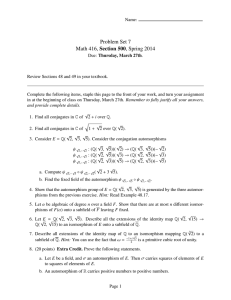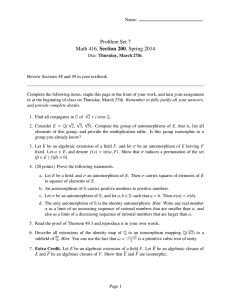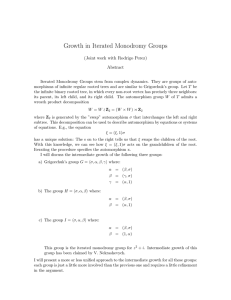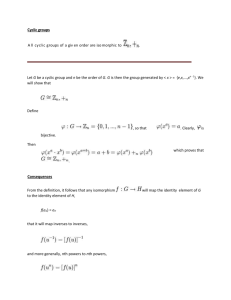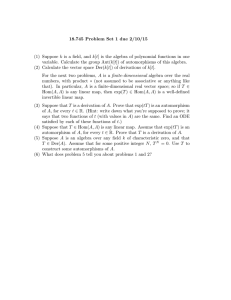ON THE NAGATA AUTOMORPHISM by Stanis law Spodzieja
advertisement
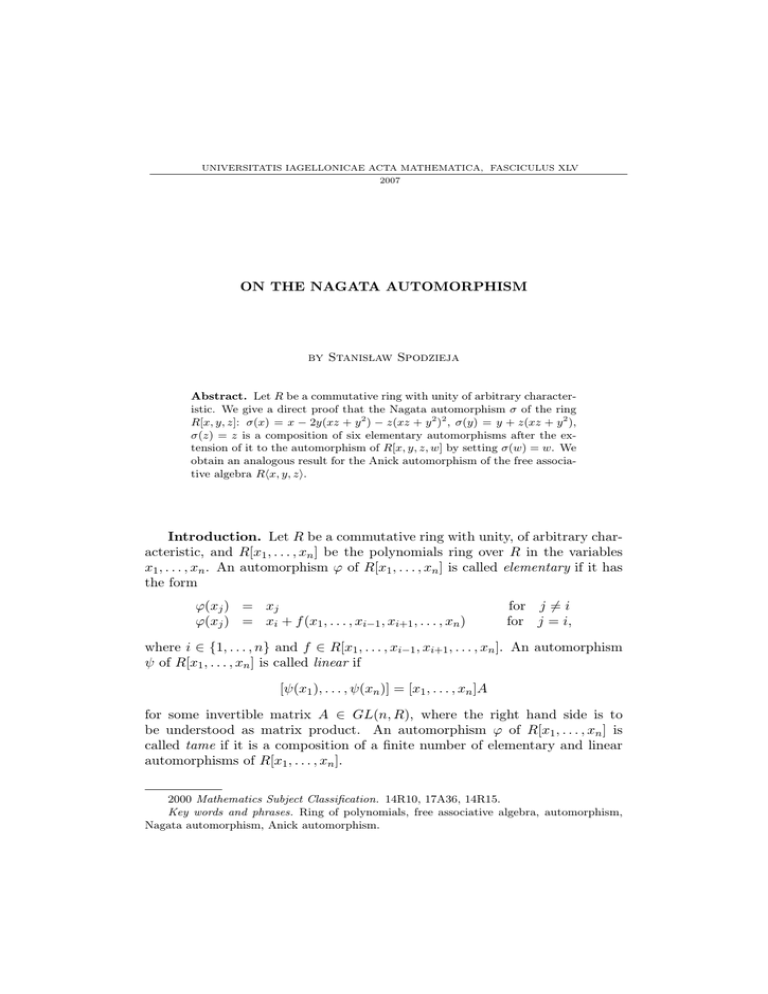
UNIVERSITATIS IAGELLONICAE ACTA MATHEMATICA, FASCICULUS XLV
2007
ON THE NAGATA AUTOMORPHISM
by Stanislaw Spodzieja
Abstract. Let R be a commutative ring with unity of arbitrary characteristic. We give a direct proof that the Nagata automorphism σ of the ring
R[x, y, z]: σ(x) = x − 2y(xz + y 2 ) − z(xz + y 2 )2 , σ(y) = y + z(xz + y 2 ),
σ(z) = z is a composition of six elementary automorphisms after the extension of it to the automorphism of R[x, y, z, w] by setting σ(w) = w. We
obtain an analogous result for the Anick automorphism of the free associative algebra Rhx, y, zi.
Introduction. Let R be a commutative ring with unity, of arbitrary characteristic, and R[x1 , . . . , xn ] be the polynomials ring over R in the variables
x1 , . . . , xn . An automorphism ϕ of R[x1 , . . . , xn ] is called elementary if it has
the form
ϕ(xj ) = xj
ϕ(xj ) = xi + f (x1 , . . . , xi−1 , xi+1 , . . . , xn )
for j 6= i
for j = i,
where i ∈ {1, . . . , n} and f ∈ R[x1 , . . . , xi−1 , xi+1 , . . . , xn ]. An automorphism
ψ of R[x1 , . . . , xn ] is called linear if
[ψ(x1 ), . . . , ψ(xn )] = [x1 , . . . , xn ]A
for some invertible matrix A ∈ GL(n, R), where the right hand side is to
be understood as matrix product. An automorphism ϕ of R[x1 , . . . , xn ] is
called tame if it is a composition of a finite number of elementary and linear
automorphisms of R[x1 , . . . , xn ].
2000 Mathematics Subject Classification. 14R10, 17A36, 14R15.
Key words and phrases. Ring of polynomials, free associative algebra, automorphism,
Nagata automorphism, Anick automorphism.
132
In 1972 (see [6], (1.1), Part 2) Masayoshi Nagata gave the following example
of automorphism σ of the ring R[x, y, z]:
σ(x) = x − 2y(xz + y 2 ) − z(xz + y 2 )2
σ(y) = y + z(xz + y 2 )
σ(z) = z
and he proved that σ is not tame as an automorphism of D[x, y], where D =
R[z] ([6], Theorem 1.4, Part 2). Simultaneously, Nagata has conjectured that
σ is not a tame automorphism of R[x, y, z] ([6], Conjecture 3.1, Part 2). This
conjecture was proved to be true by I. P. Shestakov and U. U. Umirbaev in
[7], Corollary 9. Earlier in [1] H. Bass raised the question of whether Nagata’s
automorphism of the polynomial ring in three variables is stably tame, i.e., if it
becomes tame after adding an additional variable w. M. Smith in [8] (also D. L.
Wright in an unpublished note [MR1001475 (90f:13005)], see also [5], Corollary
6.1.5) proved that σ is indeed stably tame. In the proof of the above fact,
P M.
Smith has used the exponential form of σ, i.e., σ(r) = (exp ∆)(r) =
(1/
i!)∆i (r), where ∆ is some locally nilpotent derivation of R[x, y, z, w]. Hence
the proof remains valid only in the case of rings of characteristic zero. In the
case of arbitrary characteristic, the M. Smith Theorem follows from Theorem
7 in E. Edo’s paper [4].
In the paper, we give a direct proof of the M. Smith Theorem for a ring
of arbitrary characteristic (Theorem 1, cf. [9], Theorem 1). At the end of this
note, we prove an analogous result for the well-known Anick automorphism
(see [2], p. 343) of the free associative algebra Rhx, y, zi (Theorem 2).
1. Decomposition of the Nagata authomorphism.
Theorem 1. Let R be a commutative ring with unity, of arbitrary characteristic. Then the automorphism σ of R[x, y, z, w] defined by
σ(x) = σ(x),
σ(y) = σ(y),
σ(z) = σ(z),
σ(w) = w
(under the obvious convention for characteristic 2) is a tame automorphism.
Moreover, σ is a composition of six elementary automorphisms.
Proof. Throughout the proof, one should substitute the number 0 for
the number 2, when the ring R has characteristic 2. Let τ1 , τ2 , τ3 be automorphisms of R[x, y, z, w] of the following respective forms:
τ1 (x) =
τ1 (y) =
τ1 (z) =
τ1 (w) =
x,
y,
z,
w + xz + y 2 ,
τ2 (x) =
τ2 (y) =
τ2 (z) =
τ2 (w) =
x + 2yw − zw2 ,
y,
z,
w,
τ3 (x) =
τ3 (y) =
τ3 (z) =
τ3 (w) =
x,
y − zw,
z,
w,
133
Obviously, they are elementary automorphisms of R[x, y, z, w] (for any ring
R). Moreover, τ1 (w − (xz + y 2 )) = w, so
τ1−1 (w) = w − (xz + y 2 ),
and obviously, τ1−1 (x) = x, τ1−1 (y) = y, τ1−1 (z) = z. Analogously, we obtain,
τ2−1 (x) = x − 2yw + zw2
and
τ3−1 (y) = y + zw.
To complete the proof, it is sufficient to show that
σ = τ2 ◦ τ3 ◦ τ1 ◦ τ3−1 ◦ τ2−1 ◦ τ1−1 .
To this end, we only need to prove that
σ ◦ τ1 ◦ τ2 ◦ τ3 ◦ τ1−1 ◦ τ3−1 ◦ τ2−1 (a) = a
(1)
for
a ∈ {x, y, z, w}.
Since σ(xz + y 2 ) = xz + y 2 (see (1.2) in [6]), then
σ ◦ τ1 (x) = σ(x),
σ ◦ τ1 (y) = σ(y),
σ ◦ τ1 (z) = z,
σ ◦ τ1 (w) = τ1 (w) ,
thus
σ ◦ τ1 ◦ τ2 (x) = x − 2y(xz + y 2 ) − z(xz + y 2 )2
+ 2[y + z(xz + y 2 )][w + (xz + y 2 )] − z[w + (xz + y 2 )]2
= x + 2yw − zw2 = τ2 (x),
σ ◦ τ1 ◦ τ2 (y) = σ(y),
σ ◦ τ1 ◦ τ2 (z) = z,
σ ◦ τ1 ◦ τ2 (w) = τ1 (w).
Hence
σ ◦ τ1 ◦ τ2 ◦ τ3 (x) = τ2 (x),
σ ◦ τ1 ◦ τ2 ◦ τ3 (y) = y + z(xz + y 2 ) − z[w + (xz + y 2 )] = y − zw = τ3 (y),
σ ◦ τ1 ◦ τ2 ◦ τ3 (z) = z,
σ ◦ τ1 ◦ τ2 ◦ τ3 (w) = τ1 (w),
134
and in consequence
σ ◦ τ1 ◦ τ2 ◦ τ3 ◦ τ1−1 (x) = τ2 (x),
σ ◦ τ1 ◦ τ2 ◦ τ3 ◦ τ1−1 (y) = τ3 (y),
σ ◦ τ1 ◦ τ2 ◦ τ3 ◦ τ1−1 (z) = z,
σ ◦ τ1 ◦ τ2 ◦ τ3 ◦ τ1−1 (w) = w + (xz+y 2 ) − [(x+2yw−zw)z + (y−zw)2 ] = w.
From the above it follows that σ ◦ τ1 ◦ τ2 ◦ τ3 ◦ τ1−1 ◦ τ3−1 = τ2 , and so (1) is
proved.
Remark 1. Let us consider the problem of the decomposition of an automorphism into elementary automorphisms, admitting triangular endomorphisms of R[x, y, z] of the form
α(x) = xf (y, z),
α(y) = yg(z),
α(z) = z,
where f ∈ R[y, z], g ∈ R[z]. Then the Nagata automorphism σ has a decomposition into a finite number of elementary automorphisms and triangular
endomorphisms of R[x, y, z] of the following form:
α ◦ σ = γ1−1 ◦ γ2 ◦ γ1 ◦ α ,
where α is an endomorphism of R[x, y, z] defined by
α(x) = xz,
α(y) = yz,
α(z) = z,
and γ1 , γ2 are elementary automorphisms of R[z, y, z] of the following respective form:
γ1 (x) = x − y 2 ,
γ2 (x) = x,
γ1 (y) = y,
γ2 (y) = y + xz 2 ,
γ1 (z) = z,
γ2 (z) = z.
Indeed, let ϕ be an endomorphism of R[x, y, z] of the form
ϕ(x) = x − 2yz 2 (x + y 2 ) − z 4 (x + y 2 )2 ,
ϕ(y) = y + z 2 (x + y 2 ),
ϕ(z) = z.
Then, it is easy to show that
σ◦α=α◦ϕ
and that ϕ = γ1−1 ◦γ2 ◦γ1 . In particular, ϕ is a tame automorphism of R[x, y, z].
135
2. Decomposition of the Anick authomorphism. Let R be a commutative ring with unity, of arbitrary characteristic, and Rhx1 , . . . , xn i be the free
assiociative algebra over R with free generators x1 , . . . , xn . An automorphism
ϕ of Rhx1 , . . . , xn i is called elementary if it is of the form
for j 6= i
for j = i,
ϕ(xj ) = xj
ϕ(xj ) = xi + f (x1 , . . . , xi−1 , xi+1 , . . . , xn )
where i ∈ {1, . . . , n} and f ∈ Rhx1 , . . . , xi−1 , xi+1 , . . . , xn i. An automorphism
ψ of Rhx1 , . . . , xn i is called linear if
[ψ(x1 ), . . . , ψ(xn )] = [x1 , . . . , xn ]A
for some invertible matrix A ∈ GL(n, R), where the right hand side is to
be understood as matrix product. An automorphism ϕ of Rhx1 , . . . , xn i is
called tame if it is a composition of finite number of elementary and linear
automorphisms of Rhx1 , . . . , xn i.
Let us consider the Anick automorphism δ of the algebra Rhx, y, zi:
δ(x) = x + z(xz − zy)
δ(y) = y + (xz − zy)z
δ(z) = z.
It is easy to observe that δ as an automorphism of R[x, y, z], is tame. In the
case of free associative algebras Rhx, y, zi over field R of characteristic zero, the
automorphism δ is not tame (see [10, 3]) and it is stably tame (see [8]). We
prove that δ is stably tame for a ring R with unity, of arbitrary characteristic.
Theorem 2. Let R be a commutative ring with unity, of arbitrary characteristic. Then the automorphism δ of Rhx, y, z, wi defined by
δ(x) = δ(x),
δ(y) = δ(y),
δ(z) = δ(z),
δ(w) = w
is a tame automorphism. Moreover, δ is a composition of six elementary automorphisms.
Proof. Let δ1 , δ2 , δ3 be elementary automorphisms of Rhx, y, z, wi of the
following respective forms:
δ1 (x) =
δ1 (y) =
δ1 (z) =
δ1 (w) =
x,
y,
z,
w − xz + zy,
δ2 (x) =
δ2 (y) =
δ2 (z) =
δ2 (w) =
x,
y + wz,
z,
w,
δ3 (x) =
δ3 (y) =
δ3 (z) =
δ3 (w) =
Then we easily deduce that δ = δ3−1 ◦ δ2−1 ◦ δ1−1 ◦ δ3 ◦ δ2 ◦ δ1 .
x + zw,
y,
z,
w,
136
References
1. Bass H., A nontriangular action of Ga on A3 , J. Pure Appl. Algebra, 33, No. 1 (1984),
1–5.
2. P. M. Cohn, Free rings and their relations. Second edition. London Mathematical Society
Monographs, 19. Academic Press, Inc. [Harcourt Brace Jovanovich, Publishers], London,
1985.
3. Drensky V., Yu J-T., The strong Anick conjecture is true, Preprint
http://hkumath.hku.hk/~imr/IMRPreprintSeries/2005/IMR2005-04.pdf
4. Edo E., Totally stably tame variables, J. Algebra, 287, No. 1 (2005), 15–31.
5. van den Essen A., Polynomial automorphisms and the Jacobian Conjecture, Progr. Math.,
190, Birkhäuser-Verlag, Basel, 2000.
6. Nagata M., On automorphism group of k[x, y], Kinokuniya Book Store, Tokyo, 1972.
7. Shestakov I. P., Umirbaev U. U., The tame and the wild automorphisms of polynomial
rings in three variables, J. Amer. Math. Soc., 17 (2004), 197–227 (electronic).
8. Smith M. K., Stably tame automorphisms, J. Pure and Appl. Algebra, 58 (1989), 209–
212.
9. Spodzieja S., O automorfizmie Nagaty, Materialy XXVI Konferencji Szkoleniowej z geometrii Analitycznej i Algebraicznej Zespolonej, Wyd. UL, Lódź, 2005, 39–42 (in Polish).
10. Umirbaev U. U., The Anick automorphism of free associative algebras, Preprint
http://arxiv.org/abs/math.RA/0607029
Received
February 27, 2007
Faculty of Mathematics
University of Lódź
ul. S. Banacha 22
90-238 Lódź
Poland
e-mail : spodziej@math.uni.lodz.pl
